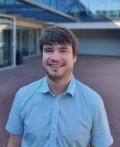 This thesis is about the further development of high-dimensional spatial-alphabet quantum communications. ‘Especially in encrypted video communication the quantum key generation rate is the main bottleneck,’ Tristan Tentrup explains the topical relevance of his PhD work.
This thesis is about the further development of high-dimensional spatial-alphabet quantum communications. ‘Especially in encrypted video communication the quantum key generation rate is the main bottleneck,’ Tristan Tentrup explains the topical relevance of his PhD work.
The approach chosen in this thesis is to exploit properties of photons besides the polarization [“0”and “1”], to increase the information content of the photons.
‘This is called a higher-dimensional Hilbert space,’ Tristan says. ‘We worked on novel methods with a two-fold purpose. Increasing the dimension of the basis using a large alphabet, increases the information content per photon together with an improvement in the communication security.’
In recent quantum communication history, the BB84 Quantum Key Distribution protocol, presented by Charles Bennett and Gilles Brassard in 1983, counts as a first milestone.
‘Secure distant communication between two persons A and B – I always call them Alice and Bob - is possible then,’ says Tristan. ‘Its security is based on the no-cloning theorem, stating that an unknown quantum state can’t be perfectly cloned.’
High-dimensional
Extending the basis of this protocol, within this PhD, Tristan experimented with high-dimensional quantum communication. Under lab conditions it was demonstrated that high-dimensional encoding using two-bases BB84 Quantum Key Distribution, was conceivable, with 1024 distinguishable symbols in two mutually unbiased bases with a shared information of 7 bit per sifted photon.
‘In all of our experiments we really pushed the physical limits,’ Tristan says. ‘We were able to build the encoding photon generation and communication protocol, to analyse the measurements results and to show its theoretical limits. It attracted international interest, as MIT Technology Review cited our work already in the second year of my PhD. I was totally surprised, as Facebook friends attended me to this publication, asking me if the work they read about really was mine.’
Experimental work
His theoretical background helped Tristan to come up with clever experimental ideas. ‘But my work in experimental physics was only just starting at the beginning of my PhD,’ he says.
‘Within the weekly group meetings of Complex Photonics Systems (COPS), the input of my colleagues was valuable for me. They not only told me when experimental ideas were unrealistic, but came up with new strategies, ideas and practical suggestions to proceed my work. Also the Applied Nanophysics meetings, in which all Mesa+ optical Groups participate, were fruitful. For example, in various experimental setups I used three different types of single photon sensitive cameras, always the best given the specific experimental conditions.’
Wavefronts
In the second stage of his PhD work, Tristan collaborated closely with colleagues Ivo Vellekoop and Lyuba Amitonova.
‘We combined quantum optics, high-dimensional wavefronts and multimode fibers (suitable for the transmission of complex wavefronts with many spatial dimensions),’ Tristan says. ‘In such an overlap novel area of research, teamwork is really important. We experimentally demonstrated an innovative multimode fiber communication method. It is based on a high-dimensional spatial alphabet, encoded into the guided modes of a multimode fiber by wavefont shaping.’
The experimental realization of the method provides security in a simple setup and is suitable for real-life implementations. ‘This makes commercial applications conceivable in the near future,’ Tristan says. ‘The results of my thesis work on this method will be published soon, and I hope the scale-up of this method will prove successful.’
Future work
Within the first two months after his PhD Defense, Tristan will be active as a post-doc at COPS, working on finalizing publications and on finishing experiments on topics that are familiar, or loosely connected, to his PhD work.
Tristan: ‘After that I am looking for a job in industry, preferably in Germany where my family lives. After many years of working in academics, I value a change in perspective to be very rewarding. I experienced this in my PhD work as well. Working on a more experimental level, I for example learnt that one sometimes has to make some bold decisions, by just simply trying out parallel experimental approaches in order to ensure progress to be made. On the other hand, concentration on details is still needed, for example when I found myself working on one fiber connection for a whole day.’
